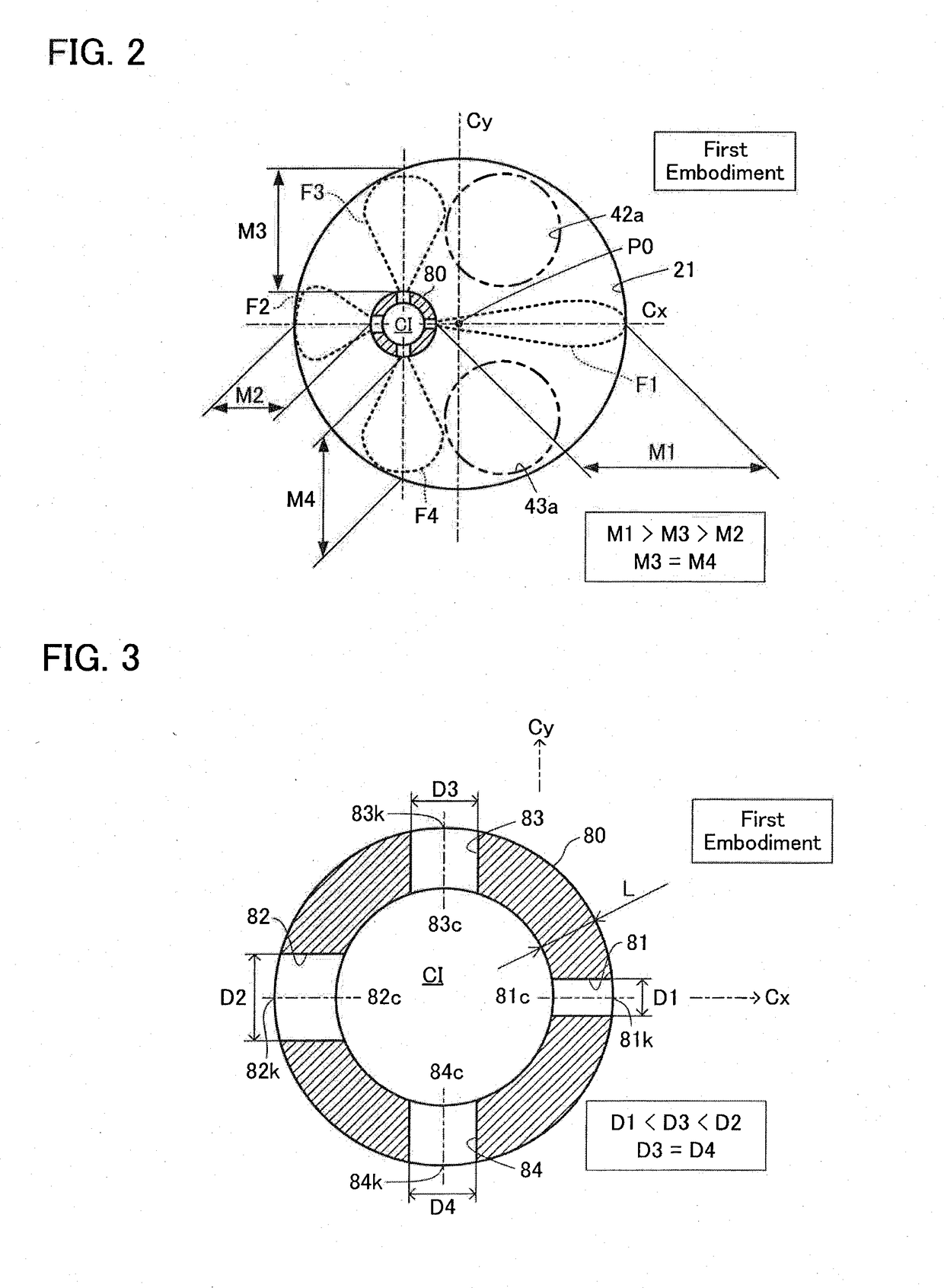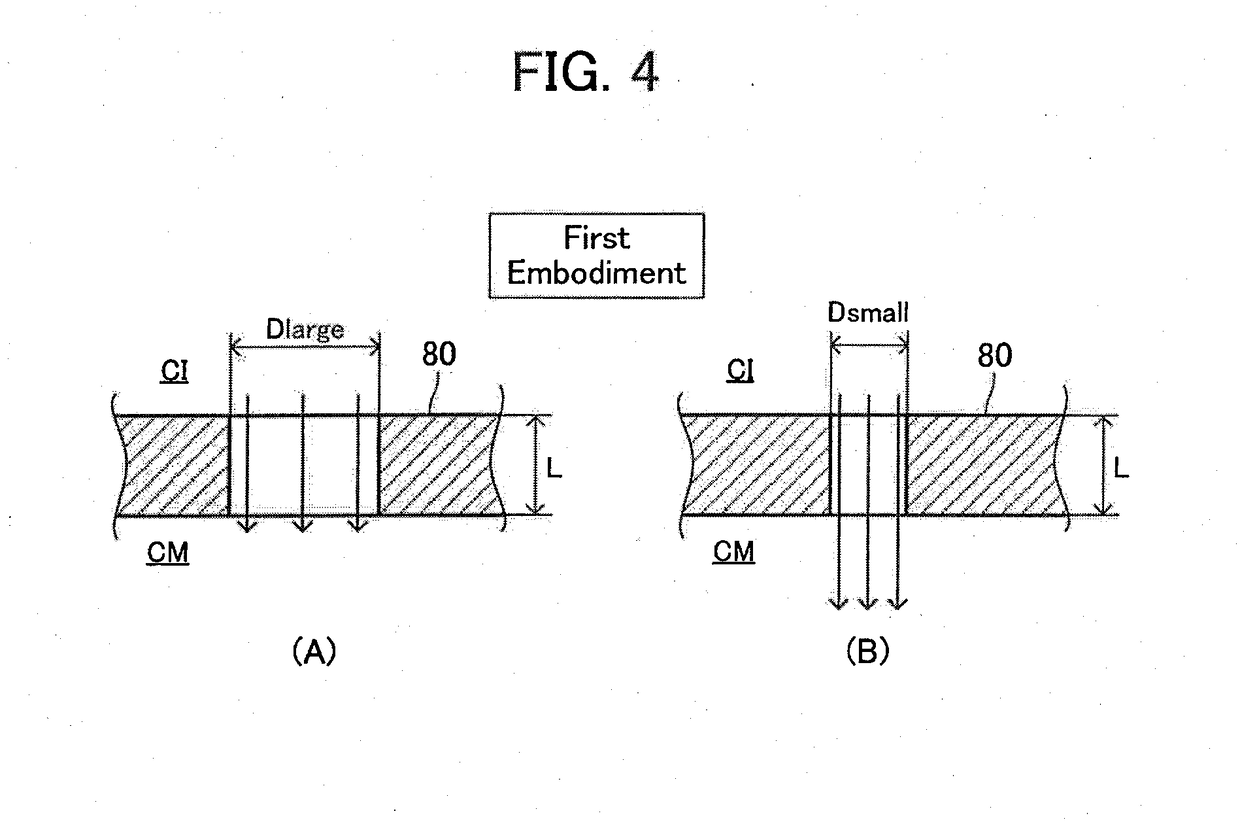Internal combusion engine
a combustion engine and combustion chamber technology, applied in the direction of machines/engines, spark plugs, mechanical equipment, etc., can solve the problems of small penetration of flame ejected from the through hole, inability to reach the vicinity of the combustion chamber wall (cylinder bore wall), and unstable combustion of fuel-air mixture remaining, etc., to achieve the effect of burning stably
- Summary
- Abstract
- Description
- Claims
- Application Information
AI Technical Summary
Benefits of technology
Problems solved by technology
Method used
Image
Examples
first embodiment
(Configuration)
[0044]As shown in FIG. 1, an engine 10 according to a first embodiment of the present invention comprises a cylinder block 20, a piston 30, a cylinder head 40, an intake valve 50, a fuel injection valve 60, a spark plug 70 and a partition wall part (barrier) 80. Furthermore, the engine 10 comprises an exhaust valve which is not illustrated in FIG. 1. In addition, FIG. 1 is a longitudinal section of a specific cylinder, and other cylinders also have the same structure as the architecture shown in FIG. 1.
[0045]The cylinder block 20 comprises a cylinder bore wall 21. The cylinder bore wall 21 forms a cylinder bore in the shape of a cylinder. In addition, a cylinder liner may be attached to the cylinder bore. In that case, the cylinder liner also constitutes a part of the cylinder bore wall.
[0046]The piston 30 has an approximately columnar shape and is housed in the cylinder bore. A cavity 31a is formed in a part (which will be referred to as a “piston crown surface part”...
second embodiment
[0076]As shown in FIG. 5 and FIG. 6, an engine according to the second embodiment of the present invention is different from the engine 10 according to the first embodiment only in a point that the engine comprises a partition wall part 90 in place of the partition wall part 80 which the engine 10 according to the first embodiment comprises. More specifically, the thickness of the partition wall part 80 was the fix length L. On the contrary to this, the thickness of the partition wall part 90 changes (varies) in its circumferential direction. Furthermore, a plurality of through holes, which the partition wall part 90 comprises, has a diameter of the same length as one another. Hereafter, explanations will be added focusing on such differences.
[0077]The partition wall part 90 comprises four through holes (the first through hole 91, the second through hole 92, the third through hole 93, and the fourth through hole 94) like the partition wall part 80. The shape of these through holes 9...
first modification
(First Modification)
[0098]In order to strengthen the penetration of the flame ejected from the through hole, as shown in (B) of FIG. 8, the shape of the end on the side of the ignition chamber CI of the through hole (edge of the entrance side opening) may be a curved surface R. In accordance with this, the swirls generated a the flame (fuel-air mixture under combustion) which flows from the ignition chamber CI into the through hole flows into the through hole can be weakened as compared with the case where the edge on the entrance side opening is a right angle shape as shown in (A) of FIG. 8. Therefore, when the shape of the edge on the entrance side opening is a curved surface shape, the swirls of the flame attenuate (disappear) before reaching the exit of the through hole (opening on the side of the main combustion chamber CM). Therefore, the flame ejected from the exit of the through hole into the main combustion chamber CM will not spread. As a result, the penetration of the fla...
PUM
 Login to View More
Login to View More Abstract
Description
Claims
Application Information
 Login to View More
Login to View More - R&D
- Intellectual Property
- Life Sciences
- Materials
- Tech Scout
- Unparalleled Data Quality
- Higher Quality Content
- 60% Fewer Hallucinations
Browse by: Latest US Patents, China's latest patents, Technical Efficacy Thesaurus, Application Domain, Technology Topic, Popular Technical Reports.
© 2025 PatSnap. All rights reserved.Legal|Privacy policy|Modern Slavery Act Transparency Statement|Sitemap|About US| Contact US: help@patsnap.com



